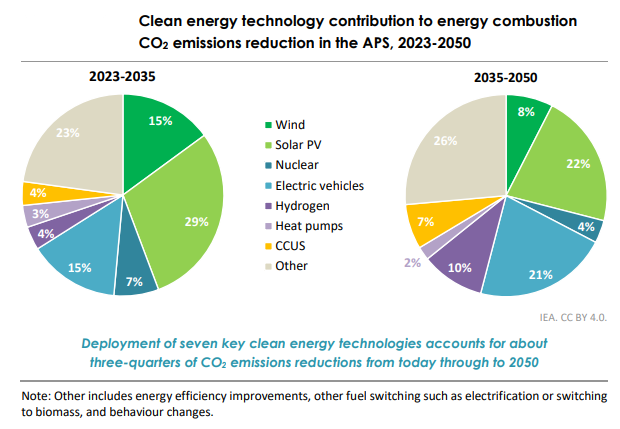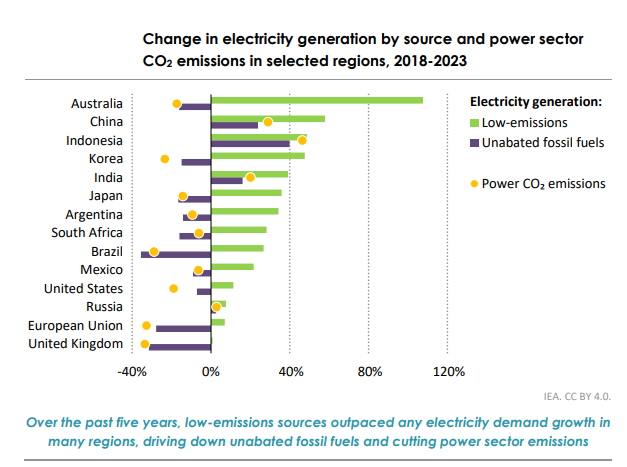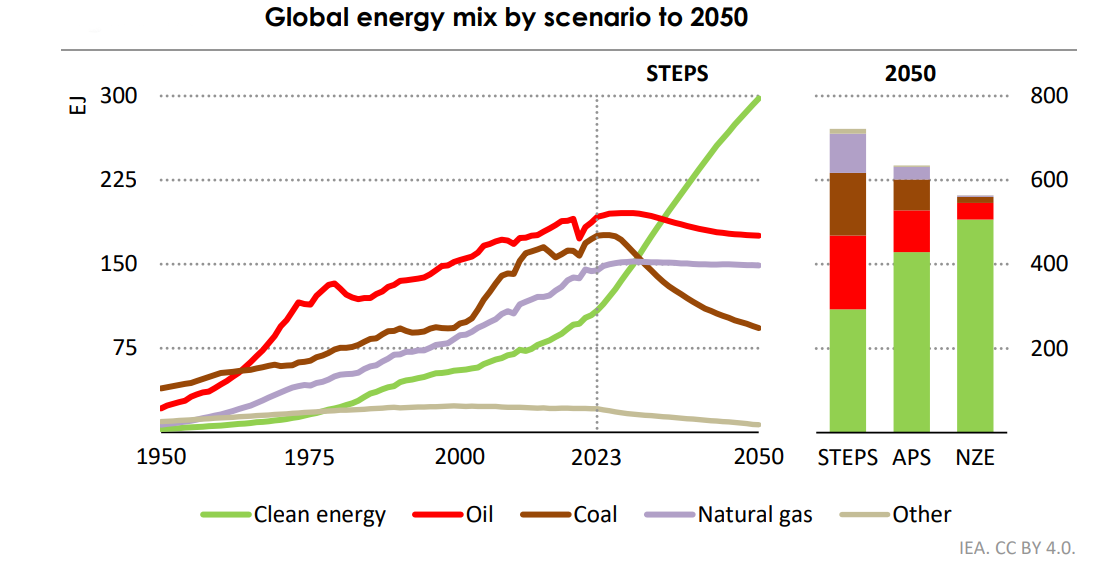Indian Economy
World Energy Outlook 2024
- 17 Oct 2024
- 13 min read
For Prelims: World Energy Outlook 2024, International Energy Agency, Renewable energy, Supply chain issues, Climate change, Net zero emissions
For Mains: Challenges in the World Energy Outlook 2024, Challenges in India’s Energy Sector
Why in News?
The World Energy Outlook 2024 released by the International Energy Agency (IEA) presents a detailed analysis of global energy trends, focusing on clean energy transitions, rising energy demand, and the impacts of geopolitical conflicts.
- India’s growing energy demand, reliance on coal, and its efforts toward achieving net zero emissions by 2070 are key aspects highlighted in the report.
What is the International Energy Agency (IEA)?
- About:
- The IEA was created in 1974 by member countries of the Organisation for Economic Co-operation and Development (OECD) to help industrialised countries respond to the major 1973-1974 oil crisis.
- Since then, its work has expanded to cover energy security, economic development, and clean energy.
- The IEA is an autonomous forum that provides analysis, data, and policy recommendations to help countries provide secure and sustainable energy.
- The IEA has four main areas of focus: energy security, economic development, environmental awareness, and engagement worldwide.
- Headquartered in Paris, France.
- The IEA was created in 1974 by member countries of the Organisation for Economic Co-operation and Development (OECD) to help industrialised countries respond to the major 1973-1974 oil crisis.
- Members:
- The IEA family is made up of 31 member countries, 13 association countries including India, and 4 accession countries.
- A candidate country to the IEA must be a member country of the OECD.
- The IEA family is made up of 31 member countries, 13 association countries including India, and 4 accession countries.
- Major Publications:
- World Energy Outlook reports.
- India Energy Outlook Report.
- World Energy Investment Report.
- The IEA Technology Roadmap and Policy Pathway series.
- The Annual Energy Efficiency Market Report.
- The Energy Technology Perspectives.
What are the Major Highlights of the World Energy Outlook 2024 Report?
- Geopolitical Tensions and Energy Security: Ongoing conflicts, such as the Russia-Ukraine war and tensions in the Middle East, continue to threaten global energy security.
- Clean Energy Transitions Accelerating: Clean energy investments have reached record highs, particularly in solar and wind power.
- In 2023 alone, over 560 gigawatts (GW) of renewable capacity was added globally, marking a significant leap towards reducing reliance on fossil fuels.
- Global Power Mix Transformation: By 2030, renewable energy is expected to become the dominant source of electricity, surpassing coal, oil, and gas.
- Solar photovoltaic (PV) and wind energy are driving this shift, and low-emission energy sources, including nuclear power, are projected to generate over 50% of the world’s electricity by the end of the decade.
- Oil and Gas Markets Facing a Surplus: The second half of the 2020s is expected to see a surplus in oil and liquefied natural gas (LNG) supply, leading to downward pressure on prices.
- Rising Electric Mobility and Oil Demand Shift: The global electric vehicle (EV) market is rapidly expanding, with EVs expected to account for 50% of new car sales by 2030.
- Clean Energy Technology Competition: The report highlights intense competition among suppliers of clean energy technologies, such as solar PV and battery storage.
- Impact of Climate Change on Energy Systems: The increasingly visible effects of climate change, such as extreme weather events, are adding new challenges to global energy systems.
- Role of Energy Efficiency: Improving energy efficiency is key to cutting emissions, but the report shows that the global target of doubling efficiency by 2030 is unlikely to be met with current policies.
What are the Key Highlights Related to India?
- India’s Economic and Population Surge: India was the fastest-growing major economy in 2023, with a 7.8% growth rate. It’s set to become the world’s third-largest economy by 2028.
- In 2023, India also surpassed China as the most populous country, despite having a fertility rate below the replacement level.
- Surging Energy Demand: India is set to experience the highest increase in energy demand globally over the next decade, driven by rapid economic growth and urbanisation.
- By 2035, total energy demand is expected to rise by nearly 35%, with sectors such as transportation, construction, and manufacturing contributing significantly.
- Strong Coal Dependency: Despite its ambitious renewable energy targets, coal remains a critical part of India’s energy mix.
- By 2030, the country is projected to add nearly 60 GW of coal-fired capacity, with coal continuing to generate more than 30% of India’s electricity, even as solar PV installations expand rapidly.
- Industrial Expansion: India’s industrial sector is poised for major growth by 2035.
- Iron and steel production is expected to rise by 70%, while cement production is projected to increase by 55%.
- Electricity Demand for Cooling: The stock of air conditioners in India is projected to grow more than 4.5 times by 2035, causing electricity demand from cooling to surge.
- The energy required for air conditioning alone in 2035 will exceed Mexico’s total projected electricity consumption for that year.
- Renewable Energy Growth and Storage Capacity: India is making significant progress in expanding its renewable energy portfolio.
- The country is on track to nearly triple its electricity generation capacity to 1,400 GW by 2035.
- Additionally, by 2030, India is set to have the world’s third-largest installed battery storage capacity, crucial for integrating variable renewables like solar and wind.
- Net Zero Emissions Target: India’s goal of achieving net zero emissions by 2070 is a key component of its energy strategy.
- The clean power generation in this trajectory is expected to be 20% higher than current policy projections by 2035.
- Electric mobility and hydrogen usage in industries are set to play a pivotal role in reducing coal and oil consumption, with India’s CO2 emissions projected to be 25% lower by 2035 compared to the Stated Policies Scenario (STEPS).
- Electric Mobility and Oil Demand Peak: The rapid adoption of electric vehicles (EVs) in India will contribute to a peak in oil demand by the 2030s.
- As more EVs hit the roads, oil demand for transport will decline, even though oil use in other areas, such as petrochemicals, will continue to rise.
- Government Policy Support: India’s clean energy ambitions are supported by strong government initiatives like the PM-KUSUM scheme for solar energy in agriculture, the National Solar Mission, and the Production Linked Incentive (PLI) Scheme for manufacturing solar PV modules.
What are the Challenges Highlighted in the Report?
- Geopolitical Risks: Conflicts, like the war in Ukraine, threaten energy security and disrupt global energy supplies.
- Supply Chain Issues: Most clean energy technologies, like solar panels and batteries, are made in a few countries. This concentration creates risks if supplies are disrupted.
- High Financing Costs: It’s becoming more expensive to fund renewable energy projects, especially in developing countries.
- Grid Infrastructure Delays: Many countries lack the grid capacity to handle the fast-growing renewable energy supply, leading to the underuse of solar and wind power.
- Slow Progress on Energy Efficiency: Efforts to improve energy efficiency are not moving fast enough to meet global targets.
- Continued Reliance on Fossil Fuels: Despite the growth in renewables, coal, oil, and gas still dominate energy use, slowing the shift to clean energy.
- Challenges for Developing Countries: Many poorer countries struggle to get the investments needed for clean energy, widening the gap in energy access.
- Impact of Climate Change: Extreme weather events, like heat waves and floods, are putting extra pressure on energy systems, increasing the need for resilience.
Way Forward
- Increase Clean Energy Investments: Governments need to boost funding for renewable energy and grid infrastructure to meet future energy demands and climate goals.
- Governments should make it easier for businesses to invest in clean energy by reducing red tape and offering incentives.
- Diversify Supply Chains: Countries should focus on reducing reliance on a few nations for clean energy technologies by building more local manufacturing capacity.
- Improve Financing for Developing Countries: Easier access to affordable financing is essential for developing economies to grow their renewable energy sectors.
- Expand and Modernise Grid Infrastructure: Investing in smarter, larger grids and energy storage will ensure renewable energy can be fully integrated and used efficiently.
- Accelerate Energy Efficiency Efforts: Stronger policies are needed to improve energy efficiency, which can significantly reduce emissions and energy demand.
- Strengthen Climate Resilience: Energy systems must be prepared to handle the impacts of climate change, such as extreme weather, by improving resilience and adaptability.
|
Drishti Mains Question: Discuss the key challenges highlighted in the World Energy Outlook 2024 regarding the global energy transition. |
UPSC Civil Services Examination, Previous Year Questions (PYQs)
Prelims:
Q1. Consider the following statements: (2019)
- Coal sector was nationalised by the Government of India under Indira Gandhi.
- Now, coal blocks are allocated on lottery basis.
- Till recently, India imported coal to meet the shortages of domestic supply, but now India is self-sufficient in coal production.
Which of the statements given above is/are correct?
(a) 1 only
(b) 2 and 3 only
(c) 3 only
(d) 1, 2 and 3
Ans: (a)
Q2. Which of the following is/are the characteristic/characteristics of Indian coal? (2013)
- High ash content
- Low sulphur content
- Low ash fusion temperature
Select the correct answer using the codes given below:
(a) 1 and 2 only
(b) 2 only
(c) 1 and 3 only
(d) 1, 2 and 3
Ans: (a)
Mains
Q. “In spite of adverse environmental impact, coal mining is still inevitable for development”. Discuss. (2017)







